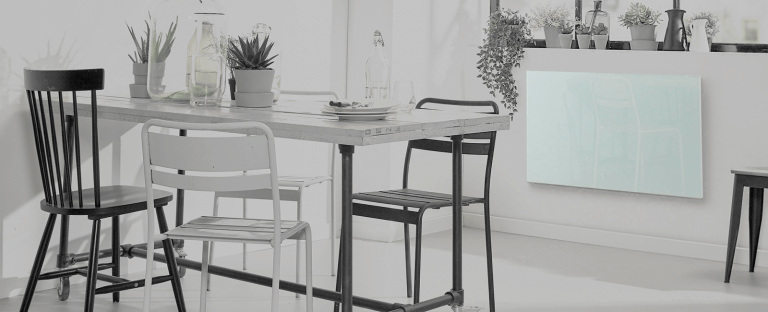What is infrared heating?
There are many different types of heating systems. Everyone will know the permanent heating that is powered by a boiler. Additionally, there is ceramic heating, convection heating, fan heaters, radiators, infrared heating, and much more. Eurom has all these types of heaters in her product range, meaning we have a lot of knowledge about the use and application of these types of heating systems. On this page we will focus on infrared heating and explain the difference with more traditional heaters. On this page we focus on infrared heating and explain the difference with traditional heating. But how does infrared heating work?

Simply put, infrared heating is a heating system powered by electricity. However, it differs from other electrical heaters. With infrared heaters the electricity is converted into infrared radiation. This allows for a more direct and more economical way of heating, making the infrared panels a good alternative to heating with gas.
Infrared radiation
When people hear infrared radiation, this often leads to health-related questions. In the case of infrared heating panels it is not necessary to be worried about the negative effects of the radiation. The infrared radiation used is long wave infrared radiation (infrared radiation type C). This type of radiation does not permeate the skin, causing no negative consequences for your health. The long wave infrared radiation is comparable to the radiation from the sun. The sun also gives of long wave radiation (besides the harmful visible UV light). This harmless infrared radiation is the warmth you feel on your skin when you are enjoying the sun. That is why our panels were given a name that honours this way of heating: Mon Soleil, in other words ‘my Sun’. So when you get an infrared heating panel, you’re literally bringing the sun into your home!
Way of heating
As discussed earlier, infrared panels differ from other heating systems. More traditional heaters like those powered by gas, or even electricity, warm up your home by means of convection. Convection is the heating of the air, causing it to move. Warm air rises, pushing cold air down. This is warmed by the heater, making it rise and causing a circulation of warmed up and cooled down air.

On the other hand, infrared heaters work by means of radiation. This radiation does not warm up the air, but the objects and people that are exposed to the radiation. This radiation warms objects and people up until three meters from the panel. Warmed up objects retain the warmth for much longer than air, causing the objects to slowly give off the heat to other objects in the room. This allows for a much more direct way of heating where no energy is lost by continuously re-heating the air. Because the objects give off their heat slowly, eventually the entire room will be warm. The difference between radiation warmth and convection warmth does take some getting used to. Nonetheless, radiation heaters have many advantages and give of a pleasant warmth. Also check how you could apply infrared heating in your home.
Infrared heating and health
An important advantage of infrared heating lies in the positive effects on your health. The fact that infrared heating does not cause air circulation means there are plenty of health benefits. Because convection circulates the air, bad particles also move around with the air. Think of for example dust and pollen. Even though these are invisible, they can still be bothersome for you and your home. For example for people with allergies, but also because dust can easily be spread around the house. Additionally, air circulation causes a draft because of the drawing in of cold air, causing your feet to always be colder than your head. Infrared heaters do not cause air circulation, meaning these problems do not exist with infrared heating.
The warming of the air also causes the air to significantly dehydrate. After all, the warming of the air causes the moisture in the air to evaporate. Dry air causes reasonably innocent discomforts like static electricity, but also dries out our skin. Furthermore, dry air can cause wooden floors to warp and crack. Because infrared does not warm up the air, you won’t have these inconveniences.
No more condensation
Another side effect of warming up the air is the formation of condensation. When moist air is heated, the moisture settles in the form of condensation. This is mostly visible with single glass, but also with more isolated houses there still is condensation. In the worst case the moisture settles in the walls, possibly leading to mould. Here also, infrared heating offers a solution, because it warms objects directly, including the walls. Thanks to this, moisture and moulds have no opportunity to settle in the walls. Therefore, infrared heating causes a much healthier environment in your home, allowing you to not only bring the temperature to higher levels, but also the health of yourself and your family.

